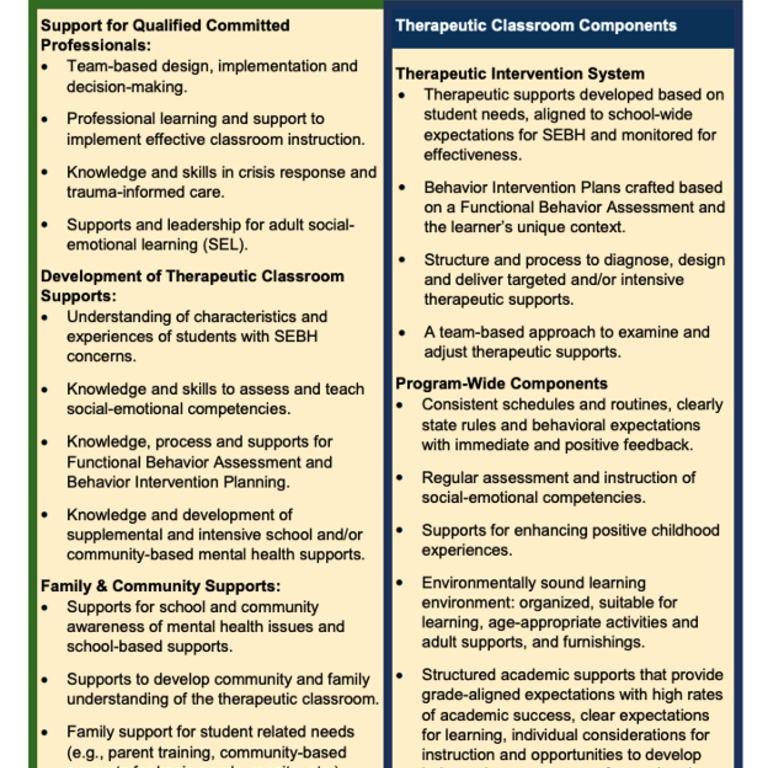Mental health concerns are on the rise for Iowa youth. Suicide, suicide ideation, and depression rates are increasing at alarming rates. As such, Iowa educators are becoming more interested in students’ social-emotional-behavioral health (SEBH). Educators are especially concerned because many have had to stop their teaching to attend to a student disruption or a behavioral problem. Not only is the individual student struggling, but the entire class’s education is also disrupted.
One possible solution could be implementing a therapeutic classroom. According to the Iowa Department of Education, a therapeutic classroom is “a safe, supportive environment where students have the opportunity to participate in planned instruction to meet their individual social-emotional needs and opportunities to engage with same-age peers to apply newly developed social-emotional skills based on an individualized timeframe and their needs and abilities.”
In short, it is a classroom built to address the educational needs of students while also attending to their social-emotional-behavioral needs. The cool part? The intensity and time are tailored for each student. It is also important to note that the ultimate goal is to work with the students’ families and home districts to reintegrate the students back into their home classrooms.
There are many components to a therapeutic classroom. Below is a graphic describing individual parts:

Evidence of Therapeutic Classrooms
Schools are the physical and social environments where youth spend most of their time, including those inclined to engage in high-risk behaviors. Schools can help protect these students and influence protective factors with social-emotional learning and prevention-based programs. Therapeutic classrooms would be considered an indicative program, serving students experiencing symptoms of anxiety, depression, self-harm, or post-traumatic stress disorder (PTSD).
According to the Substance Abuse and Mental Health Services Administration (SAMHSA), there has been an increase in Iowa youth ages 12-17 who have experienced a major depressive episode (13%) in the past year (2019), and only about half received mental health services during this time. Emotional behavioral concerns are also occurring in schools. Youth reported that 67% of their classroom teachers had to stop teaching in the last 30 days to manage a major student disruption or behavior problem in class (2019).
A meta-analysis assessing school-based mental health services for elementary-aged children found that providing therapeutic interventions multiple times per week has a moderate effect size compared to programs where interventions are provided weekly or less. The results indicate that supports that are integrated into academic instruction consistently outperform stand-alone programs (Sanchez at al., 2018).
The review also found that therapeutic interventions have positive effects on (Sanchez et. al., 2018):
- Cognitive-based and problem-solving oriented methods (e.s. = .21-1.4)
- Focus on reducing externalizing symptoms (e.s.=.5)
- Focus on reducing internalizing symptoms (e.s.=.3)
- Supports which include contingency management (e.s.=.57)
- Supports that do not include contingency management (e.s. = .24)
Sanchez et al. (2018) also identified that support should match the individuals’ circumstances, severity of their behaviors, and the desired social outcome of the program. Supports should focus on creating pro-social relationship skills, self-control and self-management skills, respect for school social rules, social compliance and cooperation with others, and social assertiveness skills.
Overall, the implementation of therapeutic classrooms is a proactive response to the escalating mental health challenges facing Iowa’s youth. Therapeutic classrooms offer a tailored approach to meet the varying needs of students, while providing a safe and supportive environment where they can grow, both academically and social-emotionally.
There is no “one size fits all” approach to therapeutic classrooms. The research demonstrates therapeutic classrooms work best when they provide individualized support that aligns with each student’s circumstances and desired outcomes.
As educators, policymakers, parents, and health professions continue to grapple with the complex challenge that is youth mental health, therapeutic classrooms emerge as potential pathways of hope. Therapeutic classrooms, emphasizing student well-being and academic achievement, provide unique spaces for students to flourish.
References
Sanchez, A. L., Cornacchio, D., Poznanski, B., Golik, A. M., Chou, T., & Comer, J. S. (2018). The Effectiveness of School-Based Mental Health Services for Elementary-Aged Children: A Meta-Analysis. Journal of the American Academy of Child and Adolescent Psychiatry, 57(3), 153–165. https://doi.org/10.1016/j.jaac.2017.11.022
Substance Abuse and Mental Health Services Administration (SAMHSA). (2020, December 29). Behavioral Health Barometer: State barometers, volume 6. SAMHSA.gov. https://www.samhsa.gov/data/report/behavioral-health-barometer-state-barometers-volume-6
This blog was co-authored by by Benson Bunker, Anna Holowicki, and Jacey Henrichs, students in the University of Iowa College of Education’s Counseling Psychology Doctoral Program.
This blog is part 1 in a 2-part series. Read part 2 here.
